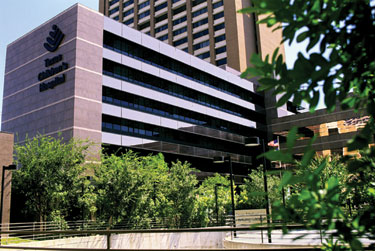Texas Children’s Hospital - Houston, TX
FAST FACTS ABOUT: Texas Children’s Hospital
Types of TDM: Modal Shift
Keywords: Transit subsidies, Vanpool Subsidies, Carpool
allowances, Recruitment and retention, Home/Life balance
Employer Demographics: Located within the largest medical
center in the
world, TCH is the largest pediatric hospital in the United States.
Results: 20% mode shift, 10% carpool/vanpool, 10% transit
Cost of Program: checking on that figure
Staff: 1 FTE for seven sites
Contact: Patsi Davis, Transportation Specialist, 832-824-2070

Recruitment and Retention
Located just southwest of Houston, Texas in the Texas Medical Center,
Texas Children’s Hospital (TCH) is the largest pediatric hospital
in the United States. A full-care pediatric hospital, the hospital’s
medical staff consists of more than 1,580 primary-care physicians, pediatric
subspecialists, pediatric surgical subspecialists and dentists. In addition,
Texas Children’s boasts a nursing and support staff of more than
6,000. TCH’s mission “to create a community of healthy children”
is leveraged by the CEO’s commitment to assist employees balance
work and home life. Given the nursing shortage and limited supply of
high quality doctors, recruiting and retaining top notch employees became
difficult for TCH. Therefore, in an effort to increase TCH’s recruitment
and retention, the CEO convened a focus group in 2001. Vice Presidents
and Directors of various departments participated in a brainstorming
session and discussed ideas on how TCH can continue to function as a
“world class” facility and attract and keep top notch employees.
Brainstormed ideas included providing free uniforms to staff, offering
$2,500 per year tuition subsidy, and instituting free parking, bus passes
and carpool allowances. All of the ideas were implemented at the cost
of $5.7 million for the first year. Highlighted among the benefits was
the flexible employee transportation benefits program.
Flexibility is Key
Recognizing the changing needs and schedules of hospital employees,
TCH’s upper management is committed to providing flexible employee
transportation benefits. Among the many benefits Texas Children’s
offers are transit subsidies, rideshare matching, vanpool subsidies,
parking management programs, pre-tax benefits, bike/walk incentives,
a telework program, flexible work schedules, a Guaranteed Ride Home
program, and shuttle service. Most of the programs are flexible from
month to month and all employees are eligible to participate. Due to
the CEO’s emphasis on home and work life, he wanted to make sure
the program maintained an “ease of use” with the program.
Employees feel like they own the program because they can pick and chose
which options are best for them at different times. For example, in
the summer months, more employees use alternative transportation modes.
These employees are eligible to receive transportation benefits strictly
for the summer months.
Management believed the presence of a
subsidy would increase participation in the transportation benefits
program.
Incentives for Options
Previous to the 2001 brainstorming session, the hospital subsidized
transit subsidies at less than 15%. After the brainstorming session,
both the number of transportation options supported by TCH and the amount
of subsidies provided increased. Management believed the presence of
a subsidy would increase participation in the transportation benefits
program. The table below summarizes TCH’s program options and
corresponding subsidies. Subsidy ranges shown are based on employee
commute distance and cover 100% of vanpool and METRO transit costs.

“Free Rides”
While not heavily marketed, when the commute options program is advertised
the messages are simple, “Free Rides” or “Manage your
home and work life”. Information about the program is given to
new hires during orientation along with free one-day passes from METRO.
Enrollment forms and information about the programs can be found on
TCH’s intranet. Additional commuter option information is published
in the company newsletters and are placed on bulletin boards in general
employee areas. TCH also works with Commute Solutions, the regional
commute alternatives program, to help get the word out to employees.
Commute Solutions offers brochures, training and a telework program
to TCH employees.
TCH has been challenged by the “it’s too good to be true”
employee mentality. Often, employees do not believe that these programs
are free. They are looking for a catch or think this is a one time only
subsidy. Once TCH management is able to clearly explain the transportation
benefits program, employees are hooked.
Make the Employees Happy
The program at TCH does not have set quantifiable goals to measure success.
Success of this program is based on employee reaction. Management does
not “worry” about the program unless there are negative
reactions to it, which has not occurred to date. TCH management strives
to ensure employees are provided with as many available commuter options
and that the program remains flexible and open ended. Surveys about
the TCH benefits package are performed regularly. The results of the
survey are compiled and given to the Vice President of the institution
on a monthly basis.
Currently, survey results show 20% of TCH employees participate in the
commute options program. Of that population, approximately 10% carpool
or vanpool, and 10% ride transit.
In addition to changing employee travel behavior, the employee benefits
program has contributed to improving TCH’s recruitment and retention
numbers. Before program implementation, the population at TCH was 3,700.
After implementation, with the addition of 1.2 million square feet to
the facility, an additional 1,800 persons were hired. TCH’s management
praises the transportation benefits program and the other employee benefits
(free uniforms, tuition) as an important recruitment and retention tool.